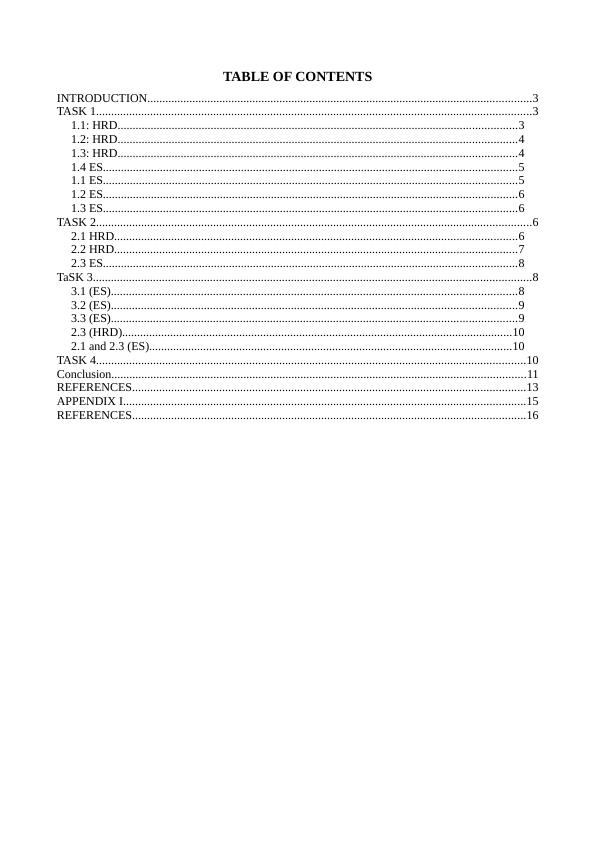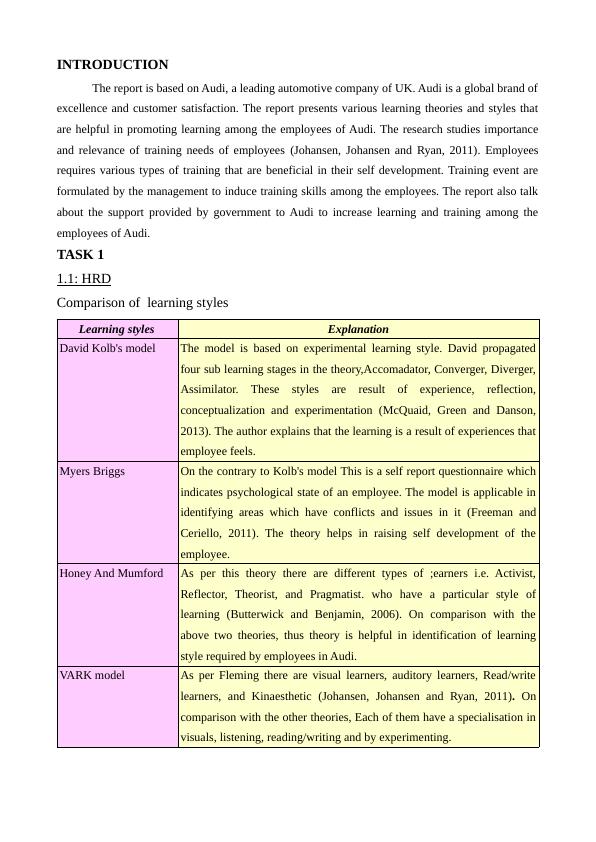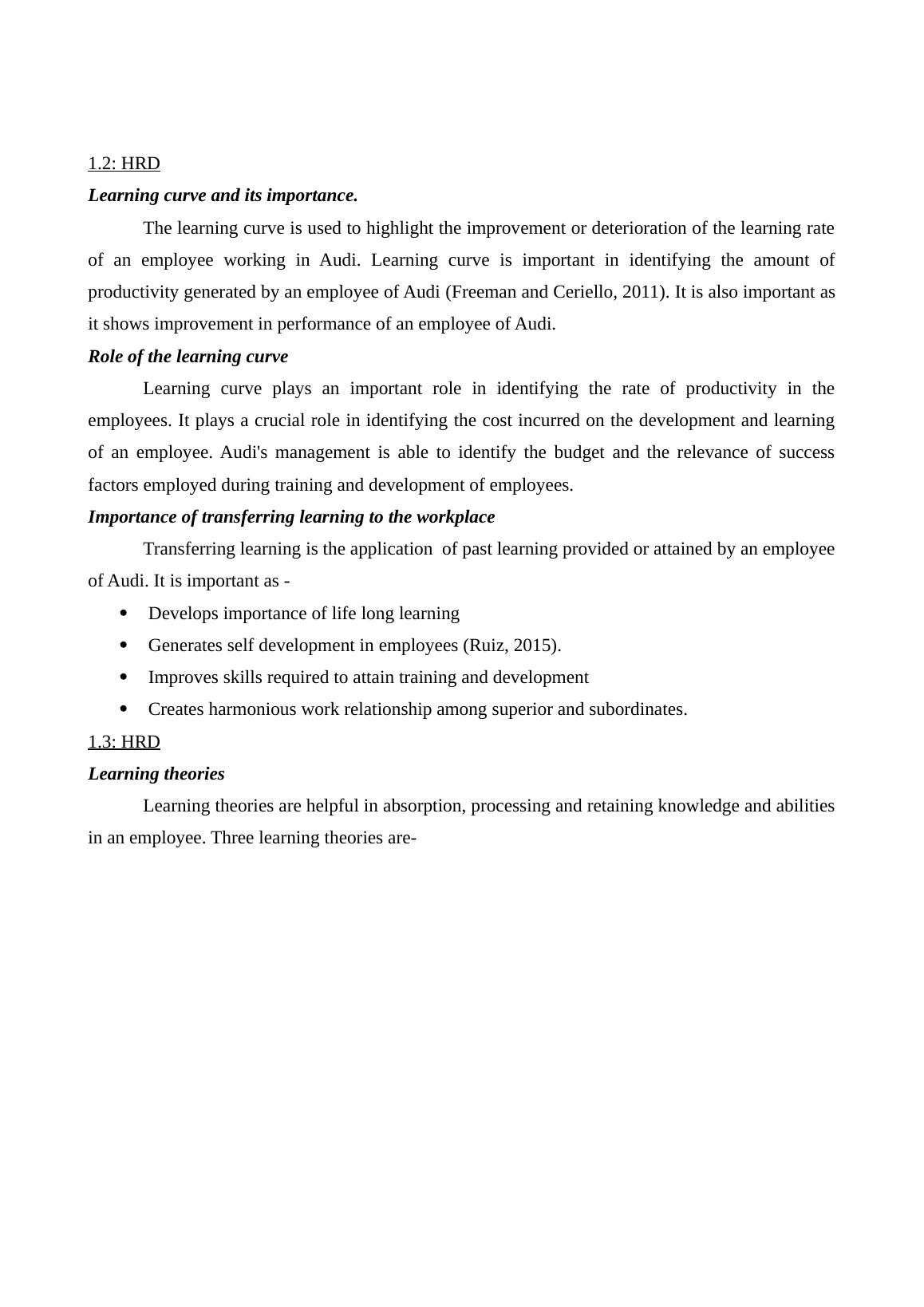Types of learning theories and learning styles
17 Pages5140 Words147 Views
Added on 2019-12-03
Types of learning theories and learning styles
Added on 2019-12-03
ShareRelated Documents
TABLE OF CONTENTSINTRODUCTION................................................................................................................................3TASK 1.................................................................................................................................................31.1: HRD.....................................................................................................................................31.2: HRD.....................................................................................................................................41.3: HRD.....................................................................................................................................41.4 ES..........................................................................................................................................51.1 ES..........................................................................................................................................51.2 ES..........................................................................................................................................61.3 ES..........................................................................................................................................6TASK 2.................................................................................................................................................62.1 HRD......................................................................................................................................62.2 HRD......................................................................................................................................72.3 ES..........................................................................................................................................8TaSK 3..................................................................................................................................................83.1 (ES).......................................................................................................................................83.2 (ES).......................................................................................................................................93.3 (ES).......................................................................................................................................92.3 (HRD)..................................................................................................................................102.1 and 2.3 (ES).........................................................................................................................10TASK 4...............................................................................................................................................10Conclusion..........................................................................................................................................11REFERENCES...................................................................................................................................13APPENDIX I......................................................................................................................................15REFERENCES...................................................................................................................................16

Illustration IndexIllustration 1: Learning Theories..........................................................................................................5Illustration 2: Organisational Levels....................................................................................................6

INTRODUCTIONThe report is based on Audi, a leading automotive company of UK. Audi is a global brand ofexcellence and customer satisfaction. The report presents various learning theories and styles thatare helpful in promoting learning among the employees of Audi. The research studies importanceand relevance of training needs of employees (Johansen, Johansen and Ryan, 2011). Employeesrequires various types of training that are beneficial in their self development. Training event areformulated by the management to induce training skills among the employees. The report also talkabout the support provided by government to Audi to increase learning and training among theemployees of Audi.TASK 11.1: HRDComparison of learning stylesLearning stylesExplanation David Kolb's modelThe model is based on experimental learning style. David propagatedfour sub learning stages in the theory,Accomadator, Converger, Diverger,Assimilator. These styles are result of experience, reflection,conceptualization and experimentation (McQuaid, Green and Danson,2013). The author explains that the learning is a result of experiences thatemployee feels. Myers BriggsOn the contrary to Kolb's model This is a self report questionnaire whichindicates psychological state of an employee. The model is applicable inidentifying areas which have conflicts and issues in it (Freeman andCeriello, 2011). The theory helps in raising self development of theemployee.Honey And MumfordAs per this theory there are different types of ;earners i.e. Activist,Reflector, Theorist, and Pragmatist. who have a particular style oflearning (Butterwick and Benjamin, 2006). On comparison with theabove two theories, thus theory is helpful in identification of learningstyle required by employees in Audi.VARK modelAs per Fleming there are visual learners, auditory learners, Read/writelearners, and Kinaesthetic (Johansen, Johansen and Ryan, 2011). Oncomparison with the other theories, Each of them have a specialisation invisuals, listening, reading/writing and by experimenting.

1.2: HRDLearning curve and its importance.The learning curve is used to highlight the improvement or deterioration of the learning rateof an employee working in Audi. Learning curve is important in identifying the amount ofproductivity generated by an employee of Audi (Freeman and Ceriello, 2011). It is also important asit shows improvement in performance of an employee of Audi. Role of the learning curveLearning curve plays an important role in identifying the rate of productivity in theemployees. It plays a crucial role in identifying the cost incurred on the development and learningof an employee. Audi's management is able to identify the budget and the relevance of successfactors employed during training and development of employees. Importance of transferring learning to the workplaceTransferring learning is the application of past learning provided or attained by an employeeof Audi. It is important as -Develops importance of life long learningGenerates self development in employees (Ruiz, 2015).Improves skills required to attain training and developmentCreates harmonious work relationship among superior and subordinates.1.3: HRDLearning theoriesLearning theories are helpful in absorption, processing and retaining knowledge and abilitiesin an employee. Three learning theories are-

End of preview
Want to access all the pages? Upload your documents or become a member.
Related Documents
Employability Skills and Human Resource Developmentlg...
|17
|4002
|256
Employability Skills and Human Resource Departmentlg...
|13
|4269
|189
Human Resource Development: Learning Styles, Training Needs, and Evaluation Techniques at Audilg...
|9
|2402
|406
Assignment on Human Resource Development in Organizationlg...
|15
|3891
|275
Human Resource Development: Learning Theories and Styles in Audilg...
|13
|2827
|289
Human Resource Development INTRODUCTIONlg...
|8
|1508
|489
